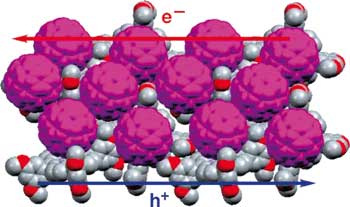| Posted: Jan 02, 2007 |
Nanohighway to solar cells |
|
(Nanowerk News) Hiroshi Imahori of Kyoto University, Japan, discusses electrophoresis as a means to make molecular highways for organic solar cells ("Electrophoretic deposition of donor–acceptor nanostructures on electrodes for molecular photovoltaics").
|
|
The shortage of fossil fuels and the degradation of the global environment has focused research attention on solar cells, which can convert sustainable solar energy into electricity. However, the cost of electricity from inorganic solar cells (silicon-based photovoltaics) is presently much higher than that generated by hydroelectric power and nuclear or fossil fuels. Therefore, it is necessary to develop low-cost solar cells with high power conversion efficiencies (η). Organic solar cells would be promising candidates if they fulfil their potential, especially as they bear unique advantages over inorganic solar cells as they are flexible, lightweight and colorful. Since the beginning of the 1990s, substantial advances in power conversion efficiency have been made in dye-sensitized solar cells (with η up to 11%) and bulk heterojunction solar cells (η up to 6%).
|
 |
| Porphyrin–fullerene 'nanohighways' for efficient hole and electron transport. (Image: RSC Publishing)
|
|
Heterojunction solar cells have two layers, a p-type donor layer and n-type acceptor. Their conduction and valence bands are at different levels, and their bandgaps are different. Light absorbed by the p-type layer generates an excited state. This migrates to the junction and is separated into an electron and a positive ‘hole’, eventually producing a current.
|
|
The molecular design of bulk heterojunction solar cells must consider three criteria: (i) extensive light-harvesting capability in the visible region, (ii) efficient energy transfer to the interface of a heterojunction and subsequent charge separation, and (iii) efficient injection of separated electrons and holes into their respective electrodes, minimizing charge recombination. Although it seems relatively easy to fulfil the first two criteria, the last one is challenging. We must construct bicontinuous interpenetrating donor–acceptor nanostructures within the mixed films: ‘hole- and electron-transporting highways’ in the films must be realized. It is thus importance to design suitable donor and acceptor molecules and elucidate the relationship between the molecular structures, their arrangements on electrodes and the photovoltaic properties.
|
|
Electrophoresis is a technique for separating proteins and nucleic acids. This technique can be applied to film deposition on an electrode from colloidal dispersions, known as electrophoretic deposition, an essentially a two-step process. First, particles such as macromolecules and colloids are charged in a polar solution. Application of an electric field forces the charged particles to move toward one of two electrodes. Then, the particles are gradually deposited onto the electrode, leading to the formation of an organic thin film. Thus, it is a fast and economical process that makes it possible to control and fabricate nano- and micro-structures on an electrode surface. We have focused on electrophoretic deposition that allows donor and acceptor molecules to be assembled onto electrodes for molecular photovoltaics. In particular, using weak intermolecular interactions (such as hydrogen bonding or lyophobic interactions) during the deposition process is also crucial for the bottom-up fabrication of donor and acceptor molecules on electrodes.
|
|
We made segregated nanoarrays of porphyrin and fullerene on a nanostructured tin oxide electrode quite simply. We introduced methoxy groups at the meta positions of the meso-phenyl groups of tetraphenylporphyrin and combined this with electrophoretic deposition. This lead to complexation and nanocrystallization between porphyrin and C60 The molecular 'highways' on the electrode allow the photoelectrochemical device to undergo ultrafast electron transfer (faster than 100 femtoseconds) between the supramolecular complex of the porphyrin and C60 molecules. This is followed by hole and electron relay through the nanostructured one-dimensional porphyrin chains and two-dimensional C60 sheets, resulting in efficient photocurrent generation. This is the first experimental demonstration for the importance of bicontinuous interpenetrating donor–acceptor nanostructures within the mixed films in molecular-level. Such results will provide many valuable insights into the design of organic solar cells.
|

